Picked up this listed as a 1962 W60 whangee Tanshell from smokingpipes.
Very nice little pipe, but I'm going to disagree with the dating. I think it's actually a 1952 pipe. The date code is a superscript sized, underlined 2 alongside W60, group 4, and T stamps. No COM on the stummel.
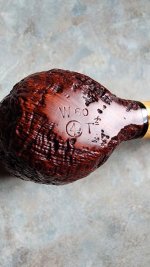
No markings on the bamboo stem but there are the remains (very faint) of Dunhill over London transversely on the bottom of the stem.
The blast is also very textured, similar to my 1952 Tanshell Friendly
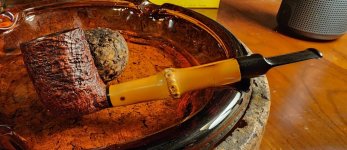
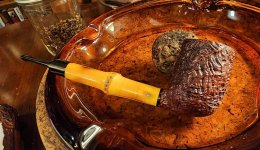
Compared to a known 1952
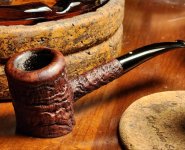
The date code corresponds to 1952 more closely than 1962, and I've seen photos of a W60 whangee with a full sized, non underlined 2 as a date code. That pipe also had Dunhill on the bottom of the stummel, not the bit.
Taken together, I think this adds up to a possible 1952 pipe, the first year that the Tanshell finish was in full production, but maybe I'm seeing what I want to see...
On the minus side, the stem has had a tenon replacement (undisclosed) and I needed to fix a little chamber charring using the wonderful Mr. Dibos' water glass and charcoal method. The problems weren't enough to return the pipe, but I wish I knew about the tenon beforehand.
Very nice little pipe, but I'm going to disagree with the dating. I think it's actually a 1952 pipe. The date code is a superscript sized, underlined 2 alongside W60, group 4, and T stamps. No COM on the stummel.

No markings on the bamboo stem but there are the remains (very faint) of Dunhill over London transversely on the bottom of the stem.
The blast is also very textured, similar to my 1952 Tanshell Friendly


Compared to a known 1952

The date code corresponds to 1952 more closely than 1962, and I've seen photos of a W60 whangee with a full sized, non underlined 2 as a date code. That pipe also had Dunhill on the bottom of the stummel, not the bit.
Taken together, I think this adds up to a possible 1952 pipe, the first year that the Tanshell finish was in full production, but maybe I'm seeing what I want to see...
On the minus side, the stem has had a tenon replacement (undisclosed) and I needed to fix a little chamber charring using the wonderful Mr. Dibos' water glass and charcoal method. The problems weren't enough to return the pipe, but I wish I knew about the tenon beforehand.







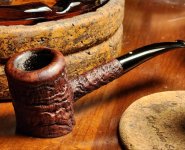
.gif)